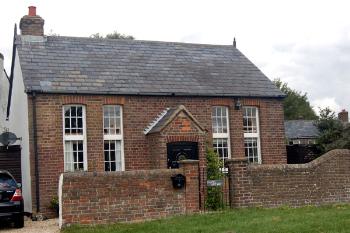Methodism in Whipsnade

The former Whipsnade chapel August 2007
Bedfordshire & Luton Archives & Records Service has just one registration of a nonconformist meeting in Whipsnade - at the dwelling house of John Searle in 1835, the person registering being Thomas Rogerson of Luton. Almost certainly this was a forerunner of the later Wesleyan chapel, since Rogerson is known to have also registered Wesleyan chapels at Barton-le-Cley, Houghton Regis, Leagrave, Luton, Tebworth and Toddington on the same day. By 1838 Whipsnade was included in the Luton Wesleyan Circuit, becoming a founder member of the Dunstable Circuit in 1843.
On Sunday 30th March 1851 a census of all churches, chapels and preaching-houses of every denomination was undertaken in England and Wales. The local results were published by Bedfordshire Historical Records Society in 1975 as Volume 54, edited by D. W. Bushby. The return for Whipsnade Wesleyan Methodist chapel was made by the steward Thomas Gadsden, who noted the following pieces of information:
- The meeting is stated to be at Whipsnade Hall [today’s Hall Farm];
- There were 50 free seats and additional space for about 188;
- The general congregation had been 8 in the morning, 29 in the afternoon and 40 in the evening;
- Averages for the preceding three months had been 6, 30 and 45 respectively.
A chapel was built in 1858. On 12th July that year the national Wesleyan Chapel Committee gave official sanction to the erection of a new chapel in Whipsnade, the cost not to exceed £100 [MB2/WHI/6/370]. The same bundle contains a list of trustees from 1878: John Hay of Whipsnade, farmer; James Elvin of Kensworth, farmer; George Flemons Hopkins of Kensworth, farmer; Charles Lockhart senior of Dunstable, gentleman; John Robinson of Dunstable, grocer; Edwin James Lester of Dunstable, warehouseman; Walter Lester of Dunstable, watchmaker; James Tearle of Dunstable, confectioner; Charles Lockhart junior of Dunstable, draper; Thomas Weatherill of Dunstable, warehouseman; James Tibbett of Dunstable, printer; Frederick Girling of Dunstable, banker's clerk; Alfred Pitkin of Dunstable, butcher; Edward Carrington George of Dunstable, gentleman; Thompson Smallwood of Dunstable, shoemaker.
In 1913 renovations were necessary and a subscription was got up to pay for them [MB2/WHI/6/370]. The total cost was £40/5/6. The First World War caused a loss of membership at Whipsnade and by 1932 there were just three members [MB2/WHI/10/3986]. This date is important because it saw the creation of the Methodist Church of Great Britain from the aggregation of the Wesleyan, Primitive and United Methodists.
With such low membership figures the chapel could not continue and in 1937, when membership fell to two, services were discontinued and the chapel officially closed the following year. It must still have been used occasionally, however, as there was expenditure on heating, lighting and cleaning which was covered by income in 1942 [MB2/WHI/10/3986].
In February 1944 the chapel was sold to Mrs. M. B. Fowler for £135 [MB2/WHI/6/370]. The money was later divided between chapels in Luton Road and Waterlow Road in Dunstable and the chapel in Houghton Regis. Notes made for The Dunstable Methodist Circuit: One Hundred and Fifty Years of Witness 1943-1993 reveal that the sale was not the end of the story [MB2/WHI/10/3986]. Mrs. Fowler sold the building to the Eldorado Ice Cream Company who used it for storage and in 1947 the company sold it to a Edmund K. Blyth, originator of the tree cathedral, who, with his father and his son, decided to try to resume Methodist worship there, services beginning again in 1948, the chapel being rededicated on 24th October and services held fortnightly, later weekly, with congregations by invitation of the owner. However, in 1964 interest had waned to such an extent that the chapel again closed. The building was sold in the late 1960s and converted into a cottage, which it remains at the time of writing [2013].